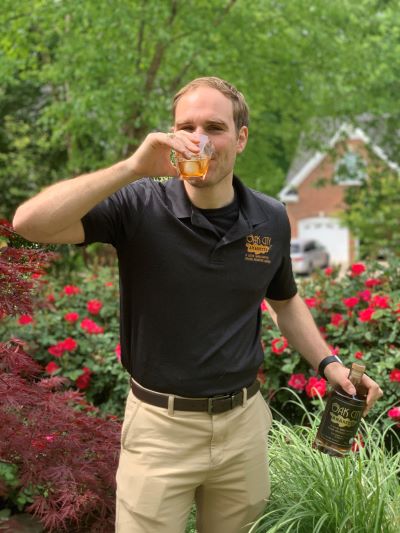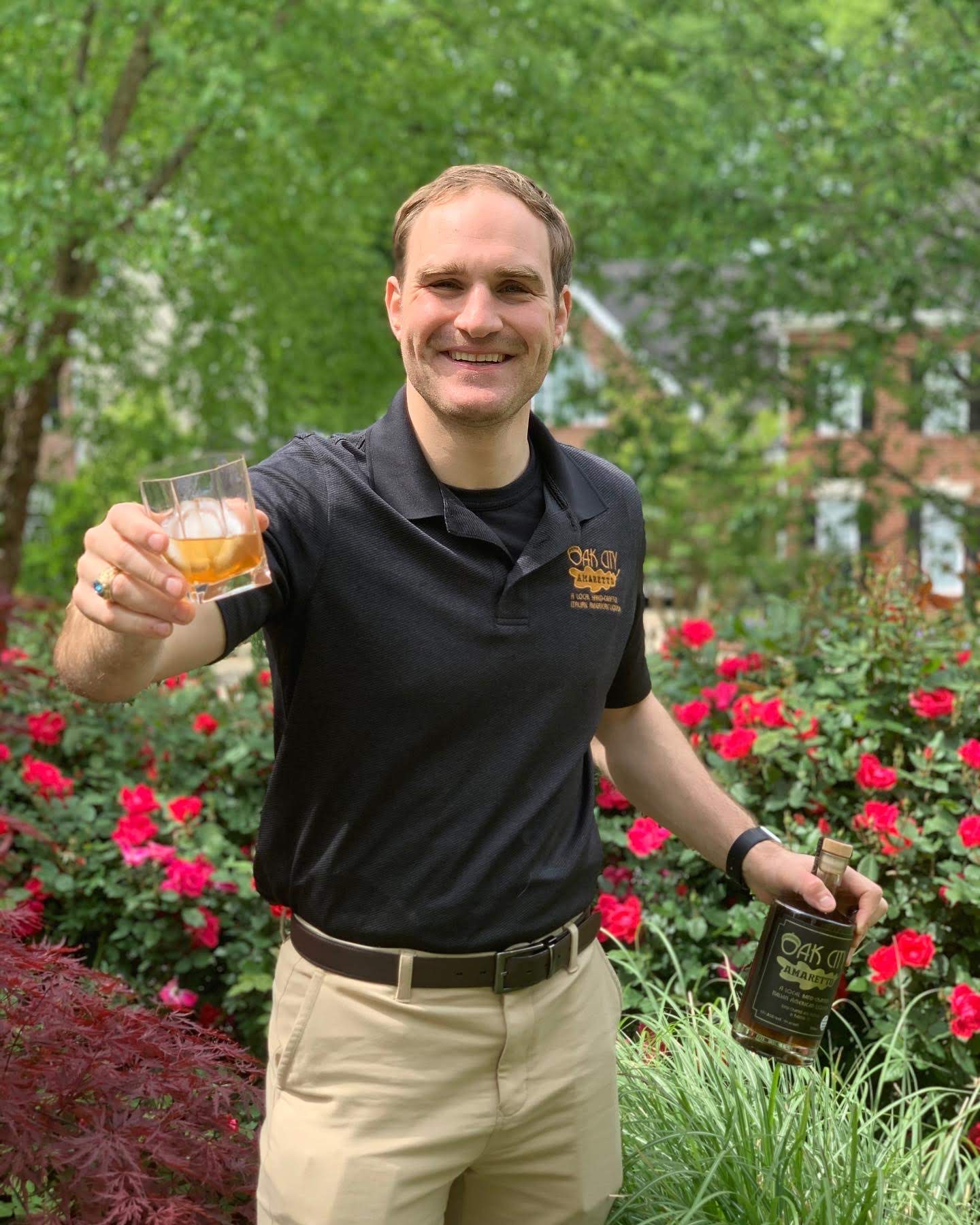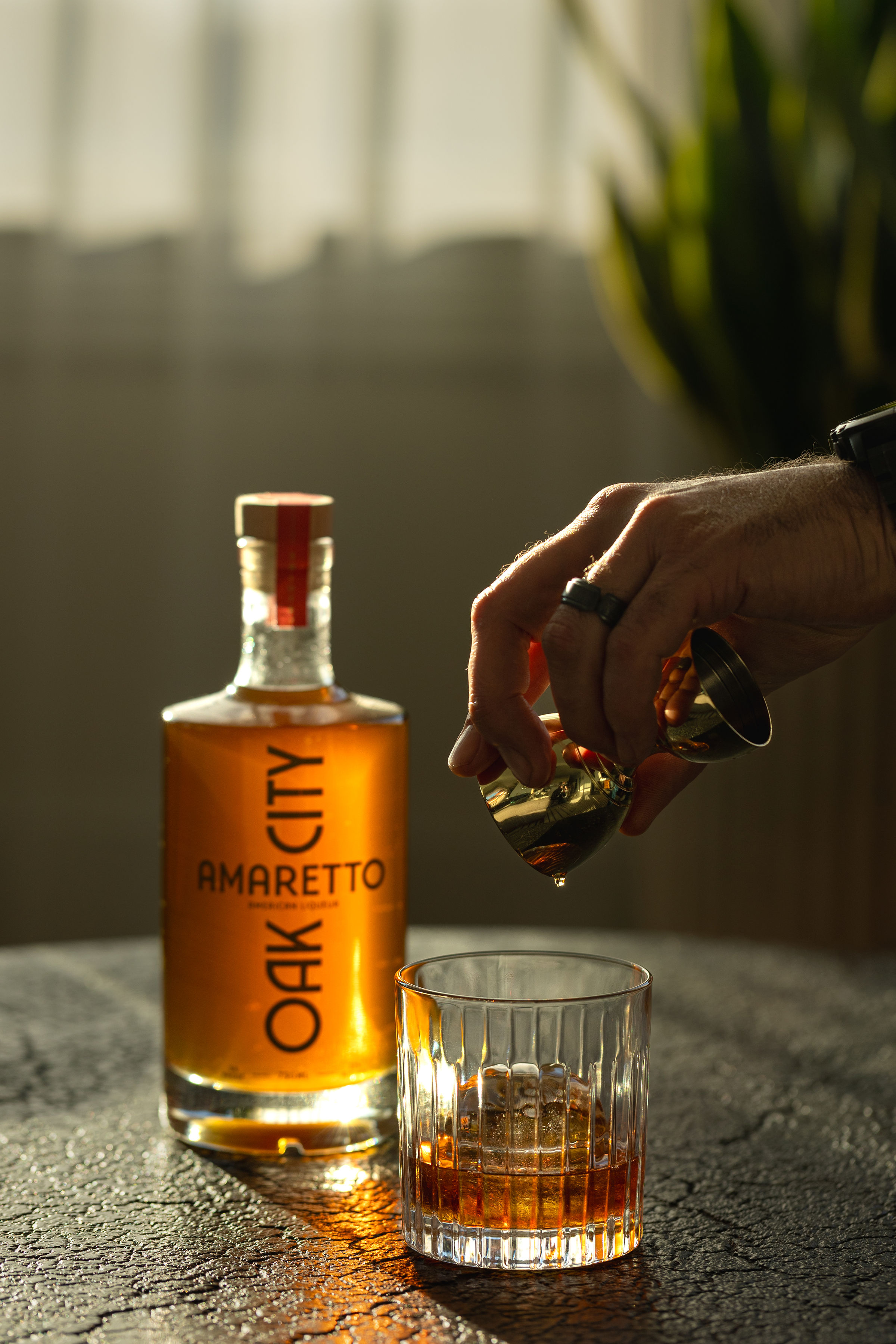Anthony Scalabrino was always close with his paternal grandmother, the daughter of Sicilian immigrants from Trapani. As a boy, he'd mow her lawn and help with painting. Their relationship became even tighter when he entered the Naval Academy. He'd call her every Sunday between studies to muse about life and dish on how their favorite team, the Detroit Lions, was playing.
"I always looked up to how devout she was as a Catholic and how patient she was in getting us kids in line like a grandmother would," Anthony remembers.
He also fondly recalls her regular Christmas present to family members and certain friends: a bottle of her own amaretto liqueur.
Anthony's grandmother passed away his senior year at the Naval Academy, but he's held onto those memories, extending her legacy by creating Oak City Amaretto, his version of Grandma Scalabrino's famous recipe.
The brand is small-batch produced and sold in North Carolina today, but Anthony aims to expand that reach to include the Midwest, particularly Milwaukee, where he's currently based. He shared his plans, how he got started, how his Navy experience shaped his journey, his preferred ingredients, his favorite way to drink amaretto, his challenges, advice for other entrepreneurs, and more.
How and why did you start Oak City Amaretto?
I really wanted to have my own business or something where I could be my own boss. In the Navy, I always responded and reported to somebody else even though I was a leader. I wanted to have my own impact and change.
Before I started, I asked for the family's blessing—not that I had to. I asked my aunt, uncle, and dad for permission and told them I wanted to do this. I didn't want to owe anybody anything or have anybody interfere unless I wanted to ask for their help. And they certainly gave me their blessing.
I was teaching ROTC at North Carolina State and earning my Master's degree in Computer Networks. I wasn't thinking about actively starting a business. Then I went on a tour at Raleigh Rum Company, which we partner with now, and I really loved their rum.
I asked my wife, Miranda, "Hey, what do you think about me making Grandma's amaretto? I don't know why I'm thinking of it, but would it be alright if I approached them with the idea?"
I contacted Raleigh Rum, and they said, "We're open to it. This is good stuff. But we had somebody approach us in the past, and they only wanted a fraction of the warehouse and to pay a hundred bucks a month or whatever, and it'd have to be more equitable than that."
We came to an agreement, and today, I use their license and tag on as one of their product lines, giving them explicit permission to manufacture my amaretto and use the brand name for the specific region.
When we started, I did everything. I bought an induction cooktop from Williams Sonoma, a stainless steel pan, and a manual paddle mixer. It starts by using a simple syrup, and you have to cook that down and reduce it. So I was doing a very large amount for me, but in reality, it was a small batch on the equipment, and I'd have to do at least 20 of those runs at a time because I didn't have anything different or more automated.
I wasn't about to go into debt to start the business, so I'd make those small 160-quart batches and pour them into two 55-gallon drums. Once they cooled, I'd mix the grain-neutral spirit, almond extract, and other ingredients into the drums.
We initially used a vineyard-style bottler. That was interesting because it was older, and there was no float to prevent leakage. And the way you did it, you could forget two ways to turn it off, one from a 55-gallon drum pouring into it, and the other is the float in the back of the filler itself.
We learned a lot from that experience. Then, I put a lot of the money back into the business, and the first thing we bought was a semi-automatic bottler. We tried some semi-automatic bottlers from China, and they broke within a couple of bottles filled. So, I began to search for what other options were out there.
I met a guy, Jeff, with a 250-gallon stainless steel tank for sale in Zebulon, North Carolina, just east of Raleigh. We retrofitted it with some legs, a mixer, and heating elements at the bottom. Then, we just went to town making a custom tank, and we still use it today. He taught me how to use the lave and heavy equipment, and we just scaled organically.
I was literally pitching the product to individual bars and restaurants. I'd take breaks in between grading papers, doing my homework, and whatever else to hit the streets, do events on weekends at bars and restaurants, and enter competitions.
How organic it's grown since the first three years has been pretty ridiculous. I continue to put in a lot of effort, but the first three years were a lot of heavy lifting and just reinvesting and seeing that money grow and put into events and things.
Anthony Scalabrino and Oak City Amaretto
How is your amaretto recipe similar to or different from Grandma's?
I actually changed the recipe a little bit. I use all-natural sugars and flavors, while she used white sugar. Oak City Amaretto tastes a little bit different, but the essence is the same. I created dozens and dozens of recipes and put five or six of my finalists in front of my dad. He chose the one that I thought was the best. It's my generational touch on the amaretto. I made it something of my own, but the idea was definitely true to her recipe.
How did your experience as a Naval Pilot and instructor shape your journey?
It was just the entirety through the Naval Academy, becoming a pilot, leader, and independent thinker. You have the emergency procedures and documentation and things you need to follow, but I think the military service just taught me how to get shit done, for lack of better terms. And that independence allowed me to just be like, "Hey, I don't know where to start, but I'm just going to start somewhere and do research and look into companies who can give me larger than individual portions of ingredients and raw material." So, pallets instead of truckloads. Just starting there, getting prices, finding the market fit, doing my research, and putting everything together helped me think about different variables and do my research. Attention to detail was really important as well.
Tell us about your ingredient sourcing and how you ensure the quality of your amaretto.
That's something we really pride ourselves in. We try to buy all-American ingredients to differentiate ourselves. That's difficult, especially with outsourcing today. I buy from local or American distributors, but our sugar isn't from the U.S. It's from Mauritius; they're a good supplier.
Quality and consistency are hard with small-batch. I had one supplier say, "We can't promise consistency." You would think it'd be the same from the cane. So, I had to switch suppliers to maintain that consistency.
We get sugar in 50-pound bags on pallets, so that's a super-key ingredient. I don't see the value in organic. It's important for certain things, but you need some GMOs and controls to keep up with the decline in farming. I get natural ingredients, like almond extract, so I don't have anything absurd and fake flavoring or anything.
Oak City Amaretto on the rocks
Do you have a favorite way to enjoy your amaretto?
My favorite is to enjoy it on the rocks with either a large ice cube or mostly crushed ice. I like chewing the ice that has been with the amaretto. One of my favorite recipes is a twist on a Tom Collins; they put some of the amaretto as the sweetener in there with some egg whites and just really fluff it up.
People think amaretto is something you shoot at a party or drink as an aperitif, but it can go in a lot of things, like an old-fashioned or something like an amaretto sour, but elevated with some whiskey and egg whites in there. There are a lot of different variations I didn't think existed, and I'm not the brainchild behind that, so I rely on local mixologists. I'm smarter on sales and operations, not the creative side.
What have been the biggest challenges and most rewarding moments in your journey with Oak City Amaretto?
North Carolina is a control state, so you have to get approved by the state. Once you get there, you have to get approved by individual boards. The challenge is that North Carolina is the legislation and the push of continuing to roll back prohibition-era legislation. That was the biggest obstacle: getting into new boards or being OK with not being in every board.
Sometimes, in small rural areas, they want to pay nine bucks to have a plastic-tasting amaretto. And because it's a government subsidy or government entity, they don't necessarily pitch your product the best. Thankfully, I've made some great relationships, and that's the alternative side: when board members and store owners have surprised me and recommended the amaretto.
The opposite side of that, going back to the hardships, is expanding out of state. And it is like a monopoly. You have the Jim Beams and the Jack Daniels. Southern Glazer's has told me, "You might not want us to represent you because we don't focus on the small brands."
Trying to find my way organically into the upmarket has been more difficult. But the big thing is finding the light in those receptive to that, whether or not that goes against what the market traditionally has been doing. It's running into those people who are more open to that difference. And that's been a constant joy.
What are your plans for the future?
Expanding to the Midwest since I'm up here now. Hopefully, that will become a reality by next year. That's the biggest thing. We're taking it in little bites. I think some people expand too quickly, and unless you have a big corporation behind you, Tito's, or something, it's hard to make that impact. My goal really is "Local small brand makes it big and shows why sourcing good ingredients matters."
What advice would you give to someone looking to start their own business?
I hear a lot from entrepreneurs: "I probably wouldn't have started knowing how difficult it was and is to run a small business." Do your market research. You could do something that there's a lot of, but you had better have a differentiator and know your market cap in the region. Understand, unless you have a differentiator and have the backing for marketing, you have to be okay with being regional, local, or maybe just statewide.
Bootstrapping was the best decision ever, and I still need to find the leap of faith to do this full-time. I work on the side, and that's been a help in fueling that. Some people say to wait until your income overlaps or is enough to take over and then make that leap. But you just need to take that leap of faith at some point.

Enjoying every sip: Anthony Scalabrino
What experience do you hope to share?
Intentionalism and authenticity—that's the biggest thing. I don't want to lose that side of the brand and who we are. That's how we got our start, and how we've expanded—just because of the community. That's had a significant impact, and I don't want to lose it.
If you enjoyed this article, consider subscribing to my newsletter for more content and updates!


